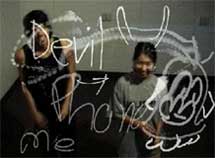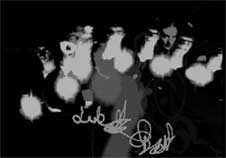Light Tracer, developed by Karl D.D. Willis, invites the participant to write, doodle, draw and trace images in physical space using light sources.
These light sources are tracked by a camera, and displayed over the participant’s own image onscreen. How participants use the system is left entirely up to them; however it is possible to write messages, draw pictures or trace physical objects such as your face or hand.

 How it works: Participants are in front of a screen reflecting the whole imagery and presented with a series of lights shources of various sizes. By pointing lights over the screen and turning them on and off, they can leave marks on the screen. Participants can also use their own light emiting devices, such as mobile phones or camera flashes, to make or trace objects on the screen. The imagery created is shown in layers which fade over time but are archived and displayed both on a second screen and on the web. Of course different participants entering the space can interact not only with the system but also play with each other or collaborate on a drawing.
How it works: Participants are in front of a screen reflecting the whole imagery and presented with a series of lights shources of various sizes. By pointing lights over the screen and turning them on and off, they can leave marks on the screen. Participants can also use their own light emiting devices, such as mobile phones or camera flashes, to make or trace objects on the screen. The imagery created is shown in layers which fade over time but are archived and displayed both on a second screen and on the web. Of course different participants entering the space can interact not only with the system but also play with each other or collaborate on a drawing.
Part of the inspiration came from the work of Myron Krueger, who from 1969 onwards developed Videoplace, an augmented reality art system that focused on ‘unencumbered full-body participation.’ The Digital Drawing module of Videoplace, in particular, allowed the user to draw on screen using their finger and erase the picture by opening their hand.
Research paper (PDF 640K). The videos on the website are pretty impressive. But check also the Luma2solator, by Amsterdam-based Pips:Lab: the installation enables the audience to make lightpaintings/grafittis, and to contribute them to the installation.
If you’re in Italy this summer, you can experience Light Tracer at BIP – Building Interactive Playgrounds, a festival for interaction design projects for public spaces and events. Part of Elettrowave, Arezzo, July 14-15 2006.
